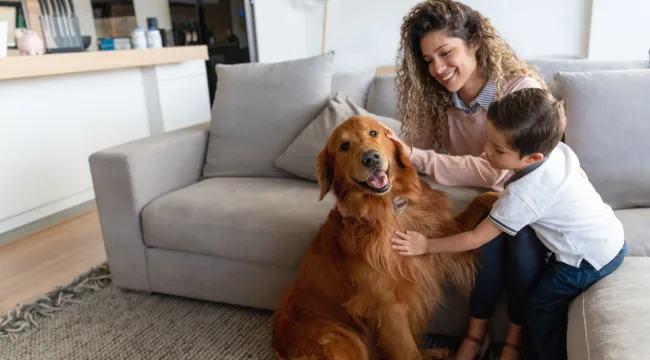
The initial 24 hours of your relationship with your pet can be tough and overwhelming. You have to balance your excitement, anticipation, and stress. You want everything to be perfect, but it’s important to remember that there will be an adjustment period.
You’re only human and are bound to make some mistakes, but with this guide, we’ll help you cover all your bases to ensure that you and your pooch put your best foot (and paw) forward for your new life together.
Let’s go over how to set your dog up for a lifetime of success by doing the first 24 hours right.
Table of Contents
- Your First 24 Hours a With New Dog
- Before Bringing Your Dog Home
- The Arrival
- How to Introduce Your New Dog to Your Current Dog
- Begin Giving Treats Immediately
- Establishing a Routine, Rest, And Bathroom Breaks
- Behavioural Observations
- Health Check
- No Visitors, Please!
- Final Words!
Your First 24 Hours a With New Dog
We will go into detail here, but keep in mind that this article is just a guideline – your experience may vary.
Dogs that are in foster-based rescues or were only in the shelter for a day or two will have an easier time adjusting to a home life than dogs that were in the shelter for weeks, come from hoarding situations, or are puppy mill survivors.
Throughout this guide, try to put yourself in your new dog’s shoes. You may already love your new four-legged friend, but your new pup doesn’t really know you yet. She doesn’t know that you’re keeping her forever – you’re just another stranger.
She’s probably had a lot of changes in her life lately, and she’ll be stressed. That stress may show as lethargy, fear, or over-excitement.
Review your dog calming signals and remember to take it slow – the first night is at high risk of triggering your dog in a negative way.
Trigger stacking is when a lot of minor stressors cause a dog to cross that red line threshold, and become fearful or aggressive (shout out to Woof Like to Meet. for inspiring our own trigger stacking diagram).
Before Bringing Your Dog Home
You should be well-prepared before your new pup steps into their new home. Gathering essential supplies is the first thing you should ensure.
- Food and water bowls
- Quality dog food is recommended by the rescue shelter and vets.
- A dog collar, leash, and ID tag for safety during walks
- A comfortable bed for relaxation and sleep
- Toys suitable for the dog’s age and size to keep them engaged
Another critical step is dog-proofing your home.
Like childproofing, this ensures the environment is safe for the new member. Keep dangerous materials like cleaning chemical supplies out of reach and set boundaries if there are areas where the dog shouldn’t go.
The Arrival
The moment of arrival is crucial. First impressions matter, even with dogs.
For first introductions, ensure family members meet the dog individually to prevent overwhelming it. If you have other pets, their introduction should be slow and always supervised to reckon reactions and prevent misunderstandings.
Allowing your dog to explore is essential. While keeping them leashed or installing an invisible fence for safety, give them a guided tour, letting them sniff around and get familiarized with their new home.
Finally, a first walk around the neighborhood can help the dog relax, familiarize itself with the new surroundings, and start bonding with you.
Meeting the Entire Family (Including the Furry Members)
Make sure you bring your whole family to meet your new dog.
If you came alone, most shelters will keep the dog for you while you go get your family members. Even if the dog is going to be primarily yours, it’s a good idea to make sure the dog gets along well with your whole family.
Even more importantly, bring your other dog(s) with you. Introduce your dogs while they’re on a leash in an open, outdoor area. This can help your first dog feel less stressed because he’ll already know your new dog before they come into his home.
How to Introduce Your New Dog to Your Current Dog
Here’s a simple way to make sure they get along:
Step 1: Find two people to help. Each person will hold a leash for one dog.
Step 2: Walk both dogs side by side with some things between them, like parked cars. This makes them feel less worried.
Step 3: Let one dog follow the other into a safe play area. Make sure there are no toys or treats on the ground that could cause a problem!
Step 4: Walk the dogs around each other in circles, keeping the leashes loose.
Step 5: With loose leashes, let the dogs say hello. The people might need to move around to make the leashes comfortable as the dogs sniff each other.
Step 6: If everything looks good, count to 3 and let go of the leashes, so the dogs can be free.
If the dogs seem upset (one stands very still, raises its tail high, growls, or snaps), separate them and try again later. Keep the dogs moving to help them feel relaxed.
Make sure you have an air horn or hose nearby just in case things go really wrong – this is the safest way to stop a dog fight!
Begin Giving Treats Immediately
After your new dog has met your family and the dog already living with you, it’s time to do some paperwork.
Bring along treats or ask the adoption counselor for some – start giving your new dog plenty of treats right from the beginning.
Even if you plan for your dog to lose some weight eventually, it’s a good idea to begin this way.
This generous treat-giving behavior helps strengthen your bond right away. Remember, you’re not bribing your dog – you’re simply showing them how awesome and cool you are!
Your new dog doesn’t know you yet, and giving them treats is a way of letting them know that you’re a fantastic person to be around, as if delicious food magically comes from you!
Establishing a Routine, Rest, And Bathroom Breaks
Dogs thrive on routine. Feeding should adhere to the schedule suggested by the shelter or rescue. If you plan to change their food brand, do it gradually to avoid digestive upset.
Next, rest and sleep are just as vital. The first day in a new home can be exhausting for a dog. Designate a quiet and comfortable sleeping spot, and ensure the environment remains calm during bedtime.
Finally, bathroom breaks are pivotal, especially in the initial hours. Take them out every few hours, and definitely after meals. Rewarding them for good potty behaviour helps reinforce training.
Behavioural Observations
Every dog reacts differently to a new environment. Some might be exuberant, while others might be reserved or even scared.
Recognizing these initial behaviours and understanding signs of stress, like excessive panting, pacing, or whining, make your job easier.
On the first day, it’s wise to keep visitors to a minimum and reduce any loud noises in the home. Offering a safe space where the dog can retreat and relax will also help them feel more secure.
Health Check
Even in the excitement of bringing a new dog home, don’t overlook their health. Be attentive to immediate concerns, such as vomiting, diarrhoea, or an obvious refusal to eat. Also, look for any signs of injuries or unusual discomfort.
Plan a visit to the veterinarian for a thorough health check-up in the coming week. This visit is an opportunity to discuss vaccinations and preventive care and address health concerns.
No Visitors, Please!
I might sound a bit boring, but please avoid having people come over during your dog’s first few days at home. Your dog has already had a big day!
These initial days are important for your dog to connect with you – it will make it simpler for future meetings since she can rely on you for comfort. Your pals can enjoy the pictures and videos on Facebook, Snapchat, and Instagram for now!
Final Words!
The first 24 hours after adopting a dog is a canvas of opportunities, challenges, and invaluable memories. It’s the start of a bond that promises to evolve each day.
While these 24 hours are foundational, It’s essential to remember that adoption is not a mere act but a commitment.
The challenges faced and cherished moments during this day serve as a testament to the affectionate journey ahead. It’s about nurturing a bond, understanding each other, and celebrating the joys of a new family member.
FAQs
What should I feed my newly adopted dog during the first 24 hours?
It’s best to feed the same food the shelter or rescue provided initially to avoid digestive upset. If transitioning to a new brand, mix it gradually over several days.
My dog seems anxious and hesitant. Is this normal for the first day?
Yes, many dogs feel overwhelmed and may exhibit anxiety or hesitation initially. Providing a quiet space and using calming techniques can help them adjust.
How can I introduce my new dog to other pets in the home?
Introduce them slowly in a controlled environment, ideally a neutral space. Supervise their interactions and reward positive behaviour for encouraging a peaceful relationship.



